|
Stock & Demi-Glace Sauce Recipe List |
|
|
|
Beef Recipe List |
|
|
|
Chicken Recipe List |
|
|
|
Lamb Recipe List |
Baked Edam with Curacao Lamb
Braised Lamb Stew on Rice
Roast Leg of Lamb
|
|
Pork Recipe List |
|
|
|
Rabbit Recipe List |
Rabbit Amandine (Coniglio con Salsa di Mandorle)
Rabbit with Cognac and Black Calamata Olives
Sweet and Sour Rabbit
|
|
Turkey Recipe List |
Italian Turkey Stuffing
Roast Turkey
Turkey Filets with Parmigiano Reggiano
|
|
Veal Recipe List |
|
|
|
Waterfowl Recipe List |
Roast Duck
|
|
| Stock & Demi-Glace Sauce Recipe List |
| Traditional All Purpose Stock |
| |
|
 Ingredients: Ingredients:
• 3 large carrots.
• 2 good size onions
• 4 cloves fresh garlic
• fresh parsley
• 1 box mushrooms
• bay leaves
• 10 pounds soup bones, the meatier the better. Use a combination of beef and veal bones.
• Total Ingredients to yield about 10 quarts
Directions:
1• Preheat oven to 375 degrees. Rinse, peel and chop the carrots, onions and garlic. Distribute the vegetables on a oven pan and lay the bones on top. Roast 2 hours until browned, turning over a few times.
2• Take out of oven and and fill a pot half full of water and drop everything and let simmer over low heat at least two hours.
3• Strain the stock through a fine strainer and then refrigerate. Throw away remnants or make a soup that evening and strain for broth.
4• After the stock has chilled for a few hours, peel off the fat and you have pure stock for adding to all meats when cooking.
With an adequate supply of traditional stock we can turn our attention to using some of the stock to produce an Espagnole sauce. It is also a key step in the production of demi-glace, which is the last stop on the bases of reduction. Even though the name "Espagnole" seems at first glance to be Spanish by origin, it is a fundamental building block of French cuisine. Hundreds of years ago France and Spain were at war with each other. During this time some culinary fusion occurred and the French sauce named Espagnole was one of the results. By adding wines, herbs, spices and cream to this mother sauce many specialized sauces are easily be made - such as a Robert sauce, Bordelaise sauce, Chateau sauce, Mushroom sauce. Another advantage is that you can quickly produce a rich sauce with no additional thickeners or added fat.
Courtesy - Permission La Lama Mountain Ovens - January 7, 2011 |
 back to top back to top |
| Veal Stock |
| |
|
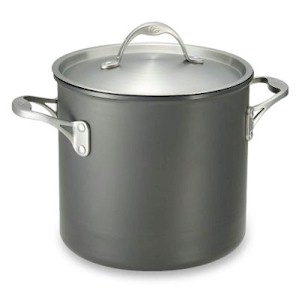 Ingredients: Ingredients:
• 2 pounds veal bones
• 1 large carrot, peeled and quartered
• 1 large onion, unpeeled, quartered
• 2 large cloves garlic, peeled
• 1 teaspoon black peppercorns
• 1 large bay leaf
• 1 rib celery, cut in half
• 1 cup hot water
• Fine sea salt and freshly ground black pepper to taste
Homemade stocks can be the building blocks of flavor for so many dishes. For rich veal stock, keep a supply of inexpensive veal shoulder bones in the freezer. Veal stock provides a light flavor for mushroom- and pasta-based dishes such as Pappardelle con Vitello.
Directions:
1• Preheat the oven to 350ºF. Generously oil a roasting pan. Add all the ingredients except the water and salt and pepper and roast for about 45 minutes, turning occasionally, until the veal bones are nicely browned. Transfer all of the ingredients to a large soup pot.
2• Pour the hot water into the roasting pan and, using a wooden spoon, scrape up any browned bits remaining in the pan. Add this liquid to the soup pot along with enough water to just cover the ingredients. Bring to a boil, lower the heat, and let simmer for 30 minutes.
3• Remove the bones and strain the stock through a cheesecloth-lined colander set over a bowl. Press hard on the solids with a wooden spoon to extract all the juices. Discard the solids. Season the stock with salt and pepper. The stock is ready to use. It can be covered and refrigerated for up to 3 days or frozen for up to 3 months. |
 back to top back to top |
| Espagnole Sauce |
| |
|
 Ingredients: Ingredients:
• 2 qt. boiling all purpose stock
• ½ lb. coarsely chopped onion
• ¼ lb. coarsely chopped celery
• ¼ lb. coarsely chopped carrots
• 5 oz. butter
• 5 oz. flour
• 1 bay leaf
• ½ cup dry Madeira Wine
• 3 oz. tomato puree
• Salt and pepper to taste
• 5 oz. butter
Directions:
1• Over medium/low heat melt butter in sauce pan. Add onions, celery and carrots. Cook until onions soften, then add flour and mix into a roux. Cook the roux for about five minutes or until it begins to brown. Begin adding hot stock, 1 cup at a time. Stir thoroughly until each cup of stock is absorbed by the roux and becomes smooth. When all the stock has been incorporated, add the remaining ingredients and adjust to taste for salt and pepper. Cook at a medium simmer for 1 ½ hours. Remove from heat and pour immediately through a fine strainer.
2• The Espagnole sauce is complete and ready for use. It will keep for about a week under refrigeration and it also freezes quite well. When defrosting frozen Espagnole, or after several days under refrigeration, you may have to thin it with a little stock to reach the consistency you desire.
3• We are now ready to do a final reduction and produce the classic demi-glace. You can choose to make a plain demi-glace, or you may infuse an herb or combination of herbs to make a flavored demi-glace. This decision must be made while assembling the ingredients in the sauce pot, before the reduction process begins. I find the plain version is more useful as you can always infuse the herb flavors later when you use the demi-glace to make a pan sauce.
Courtesy - Permission La Lama Mountain Ovens - January 7, 2011 |
 back to top back to top |
| Demi-Glace |
| |
|
 Ingredients: Ingredients:
• 2 ½ cups Espagnole sauce
• 4 cups Traditional All Purpose Stock
• 2¼ cup dry Madeira Wine
• Herb or combination of herbs if you choose
Directions:
1• Over medium/low heat combine the Espagnole Sauce and the Traditional All Purpose Stock. If you choose to infuse a flavor into the demi-glaze, add the herb or herbs at this time. Bring to a medium simmer and cook until reduced by about half, add the Madiera wine and continue reducing until you have reached 1/3 of the original volume. Stir mixture frequently through entire reduction. When finished, pour through a fine strainer.
2• When making a demi-glace, the amount of reduction is more critical than the time of cooking. You can slightly speed up the process by bringing the mixture to a faster simmer or slow it down by reducing the simmer. The 2/3 reduction is the important thing to accomplish. Bear in mind that the faster the simmer the more attention you will have to pay to avoid burning the sauce. When using herbs to infuse a flavor into the demi-glace use fresh herbs that are not cut up. This will permit you to remove them from the finished sauce with a pair of tongs rather than passing the finished sauce through a fine strainer.
Madeira wine is actually a family of wines that originate in the Madeira Islands of Portugal. The various wines that are created using the methods that have been in common use for centuries can be utilized in a number of different ways. Some types of Madeira wine are ideal for cooking, while others are more suited for use with desserts or as an aperitif.
Courtesy - Permission La Lama Mountain Ovens - January 7, 2011 |
 back to top back to top |
| |
| Beef Recipe List |
| Italian Beef Stew |
| |
|
 Ingredients: Ingredients:
• 2 pounds of stewing meat cut into small pieces
• 1 cup of flour
• 2 15oz cans of san marzano plum tomatoes
• 2 15oz cans of tomato sauce
• 1 cup of water or enough to cover vegetables
• 2 green bell pepper cut in large chunks
• 2 onions cut in half and sliced
• 5 carrots peeled and cut into circles
• 1 large zucchini sliced into circles
• 1/2 pound of fresh green beans
• 4 stalks of celery sliced in small pieces
• 5 small baking potatoes cut into pieces
• 4 cloves of garlic crushed
• 2 Tbls of dried oregano
• 1/4 cup of extra virgin olive oil
• 1 Tbls fresh ground black pepper
• 1 tsp salt
• 3 ounces of Cognac
Directions:
1•
Place meat in flour and shake off any excess.
2• Slice all your vegetables.
3• In a large frying pan brown the meat.
4• Add garlic, oregano and salt and pepper and stir some more.
5• Add Cognac and let simmer for about ten minutes and keep on stirring.
6• Add all the vegetable and stir.
7• Add tomatoes, tomato sauce and water so the vegetables are covered and stir.
8• Simmer about 1 hour and a half coveredServe with an italian loaf of bread and red table wine.. |
 back to top back to top |
| Italian Style Roast Beef |
| |
|
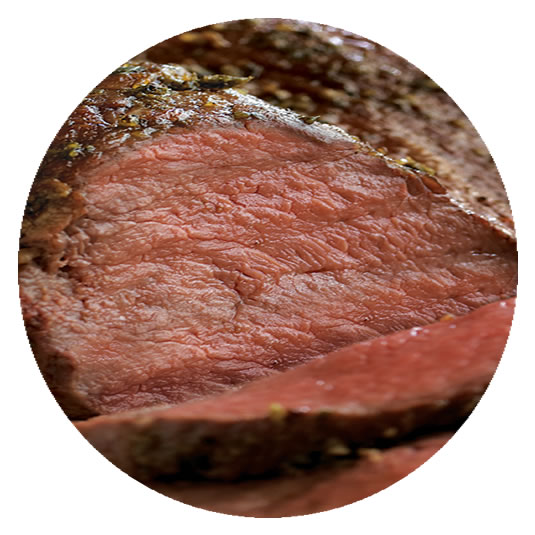 Ingredients: Ingredients:
• 2 1/2 cups water
• 3 cubes beef bouillon
• 1 teaspoon salt
• 1 teaspoon crushed garlic
• 2 tablespoons Italian seasoning
• 1 teaspoon black pepper
• 2 tablespoons dried oregano
• 10 leaves fresh basil
• 1/2 teaspoon dried red pepper flakes
• 5 pounds rib, tenderloin (fillet mignon), or the strip loin
• 1/2 cup canola oil
Directions:
1• Pour water into a roasting pan, and add bouillon cubes.
2• Mix together the salt, garlic, Italian seasoning, black pepper, oregano, basil, and red pepper flakes on a large plate. Rub roast with 1/2 cup canola oil. Roll roast in seasoning mixture until well coated. Place the roast in the roast pan along with any left over seasoning mixture and oil.
3• Sear at high heat (425) for 15 minutes, reduce heat (350), and cook approximately 3 hours. Meat should be tender and well done. It's preferable to buy a oven thermometer to make sure meat cooks properly.
Notes to read:
Cooking them no more than medium rare, 130 degrees on a meat thermometer will ensure tender meat. Remove the roast when it is 5-10 degrees shy of this temp as carry over cooking will cause it to cook further on its own. Also, allow the roast to rest for at least 15 minutes to reabsorb its juices.
Cuts from the shoulder, (chuck), chest, (brisket), or leg, (shank), are naturally tough muscles and must be cooked via a wet cooking mehtod, most notably braising. This is where your crock pot comes in. You can braise these cuts for 2-2 1/2 hours at a low temp. They will then be fall off the bone tender. |
 back to top back to top |
| Italian Traditional Meat Loaf |
| |
|
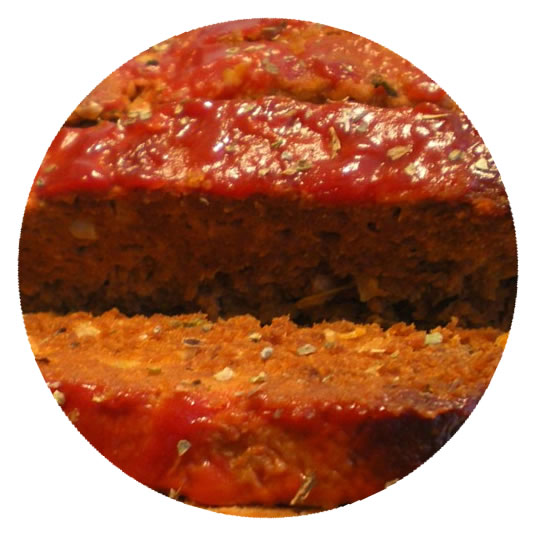 Ingredients: Ingredients:
• 2 tablespoons extra virgin olive oil
• 1 medium onion, finely chopped
• 2 garlic cloves, finely chopped
• 1 pound lean ground beef
• 1/2 pound lean ground pork
• 1/2 pound lean ground veal
• 1 egg, beaten
• 1/3 cup grated Parmesan cheese
• 2 tablespoons finely chopped fresh parsley
• Salt and black pepper
• 2 cups brown gravy, for serving
For the filling
• 1 egg, beaten
• 2 tablespoons finely chopped fresh parsley
• 1/3 cup grated Romano cheese
• 1/3 teaspoon grated nutmeg
• Salt and black pepper
• 2 eggs, hard boiled (remove shell after hard boiled)
Directions:
1• Heat the oven to 400°F. Butter a 9x5x4-inch loaf pan.
2• Heat the oil in a small skillet over medium heat. Add the onion and garlic. Cook until the onion is slightly browned, about 5 minutes.
3• In a large mixing bowl, combine the beef, pork, veal, egg, cheese, parsley, salt and pepper to taste, and the cooked onions and garlic. Mix well and set aside.
4• For the filling: In a separate bowl, combine the egg, parsley, Romano cheese, nutmeg, and salt and pepper to taste and mix well.
3• Line the bottom of the loaf pan with about 3/4 inch of the meat mixture. Build up walls on the inside of the pan that are the same thickness. Slice the hard boiled eggs and add in center. Add the remaining meat on top of the eggs so it is completely covered by the meat.
3• Place the meat loaf, uncovered, in the hot oven and bake for 50 to 60 minutes, until the top is golden brown. Remove the meat loaf and allow it to rest about 15 to 20 minutes.
3• In the meantime, heat the brown gravy. Check the stock sauce page for gravy recipe ideas
3• Slice the meat loaf and serve with brown gravy. Serves 4 to 6 |
 back to top back to top |
| Italian Style Beef Braciole |
| |
|
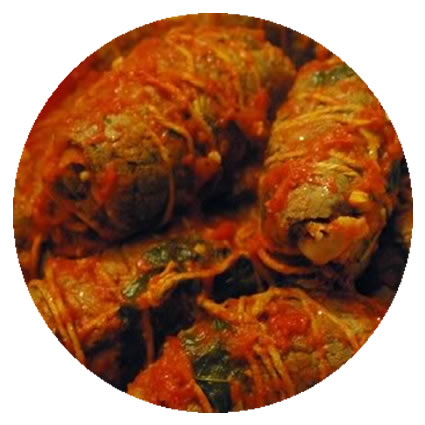 Ingredients: Ingredients:
• 1 lb boneless beef round, cut into 4 slices approximately 1/3 inch thick
• 4 slices of prosciutto
• 1 tablespoon pine nuts
• 2 tablespoons grated romano cheese
• 2 garlic cloves, chopped
• 2 tablespoons fresh parsley, chopped
• 1/2 cup olive oil
• 2 28oz cans san marzano tomatoes
• 2 bay leaves
• 3 fresh basil leaves, chopped into small pieces
• 1 medium yellow onion, chopped fine
• 2 carrots, peeled and chopped fine
• 2 celery stalks, chopped chopped fine
• 1 cup red wine
• flour spread on a plate for dredging
• salt & pepper to taste
Directions:
1• Take beef slcies and pound with a meat pounder until 1/4 inch thick. Sprinkle with salt & pepper. Lay a slice of prosciutto on each one and sprinkle evenly with with the pignoli beans, romano cheese, garlic and parsley. Roll up the slices, tucking in the ends and tie with kitchen string.
2• Heat 1/4 cup of the olive oil in a large frying pan over medium heat. Dredge the braciole in flour shaking off any excess, then place in the pan. Cook until browned on all sides, about 15 minutes.
3• Heat the other 1/4 cup of olive oil in a large saucepan over medium heat. Add the onion, carrots, and celery. Cook, stirring until tender but not browned, about 10 minutes. Add braciole, bay leaves, and salt & pepper.
4• Add red wine and cook until most of liquid evaporates, about 2 minutes. Pass the tomatoes, with their juices through a food mill or sieve into the saucepan. Fill one of the tomato cans 1/2 way with water and add to saucepan. Add tomato puree, turn heat to low and cook at a simmer until beef is tender 1.5 - 2 hours.
5• Sprinkle the basil over the rolls, and cook for 2 minutes longer. Transfer to serving plates, spoon the sauce over the top and serve at once. |
 back to top back to top |
| Old Fashioned Meatballs |
| |
|
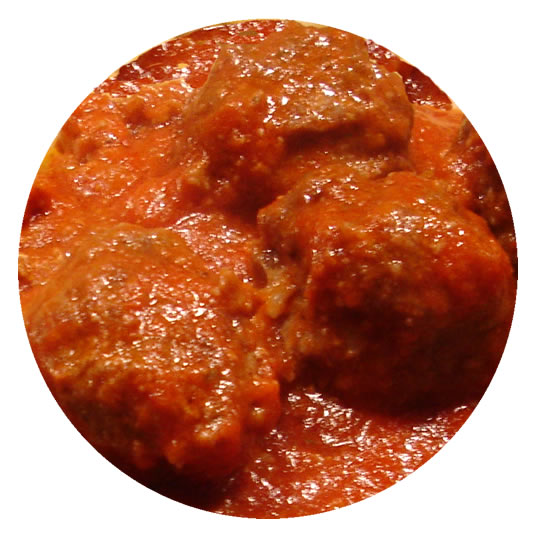 Ingredients: Ingredients:
• 1lb. ground beef / veal / pork blend
• 2 eggs
• 1/4 cup milk
• 1/2 cup plain bread crumbs
• 1/2 cup grated Parmigiano or Romano Cheese
Directions:
1• Preheat oven to 350 degrees F.
2• Mix all ingredients in a large bowl.
3• Form meat into meatballs.
4• Place on a baking sheet and bake for 20 minutes.
5• Use with your favorite tomato sauce or in sandwiches.
You can also add the raw meatballs to your tomato sauce as it's cooking.
If you like your meatballs soft add an egg. |
 back to top back to top |
| Truffle Filet |
| |
|
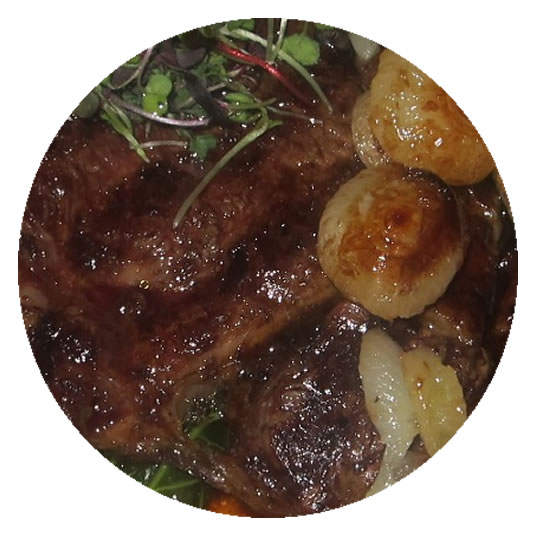 Ingredients: Ingredients:
• 1/2 lb field greens or lettuces of your choice
• 6 Tablespoons extra olive virgin oil
• 2 Tablespoons of red wine vinegar
• Salt and freshly ground pepper
• 2 oz od Parmigiano Reggiano
• 4 5oz filet mignon steaks
• White Truffle Ool to drizzle
Directions:
1• Wash and dry the greens. Whish together olive oil, vinegar, salt and pepper. Set aside
2• Make shavings of Parmigiano Reggiano with a vegetable peeler. Set aside
3• Grill individual steaks to your liking. When steaks are done, toss greens with dressing.
4• Divide salad among plates and center a steak on top
5• Salt and pepper to taste
6• Drizzle each steak with White Truffle Oil
7• Top each serving with Parmigiano Reggiano slivers and serve immediately
Serves 4. |
 back to top back to top |
| Filet Mignon with Gorgonzola |
| |
|
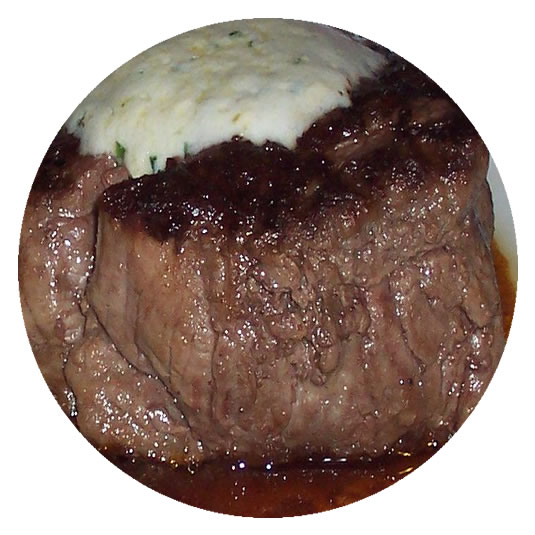 Ingredients: Ingredients:
• 4 pc filet mignon, about 3 1/2 oz. each
• 1 shallot (chopped)
• 1/2 cup gorgonzola (melted)
• 4 pieces of toast
• 1 garlic clove, salt, pepper
Directions:
1• Saute chopped shallot and garlic clove.
2• Brown filets.
3• Place each filet on a piece of toast and pour on the melted gorgonzola and season as desired.
4• Serve with potatoes.
Serves 4 |
 back to top back to top |
| |
| Chicken Recipe List |
| Chicken Cacciatore |
| |
|
 Ingredients: Ingredients:
• 1 tbsp vegetable oil 15 mL
• 6 chicken thighs, skin removed 6
• pinch each salt and pepper pinch
• 1 large onion, chopped 1
• 2 each carrots and celery stalks, sliced 2
• 1 1/2 cups sliced fresh mushrooms 375 mL
• 1 cup chopped green pepper 250 mL
• 3 garlic cloves, minced 3
• 1/2 tsp each dried basil and oregano 2 mL
• 1/4 tsp red pepper flakes 1 mL
• 1/4 cup white wine (optional) 50 mL
• 1 can (28 oz/796 mL) tomatoes
• 2 tbsp tomatoe paste 25 mL
• 1/4 cup chopped fresh parsley 50 mL
• 1 lb spaghetti 450 g
Directions:
1• In dutch oven, heat oil over medium-high heat. Sprinkle chicken thighs evenly with salt and pepper; brown each side 4 minutes. Remove from pot and set aside.
2• Reduce heat to medium; add onion, carrots, celery, mushrooms, green pepper and garlic. Cook 10 minutes or until carrots are almost tender. Stir in basil, oregano and red pepper flakes; cook 1 minute, stirring constantly.
3• Stir in wine (if using), tomatoes and tomato paste; return chicken to pot. Bring to a boil over medium heat. Reduce heat to low, cover and cook 20 minutes, stirring occasionally. Remove lid and cook 15 minutes, or until sauce thickens slightly. Stir in parsley.
4• Meanwhile, in a large pot of boiling, salted water, cook pasta 8-10 minutes, or until tender but firm. Drain pasta and toss with 1 cup (250 mL) of sauce. Place pasta on serving platter and top with remaining sauce and chicken.
Preparation Time: 20 minutes
Cooking Time: 55 minutes
Makes 6 servings
Bonne appetit. Elena |
 back to top back to top |
| Chicken Fried Asiago Cheese |
| |
|
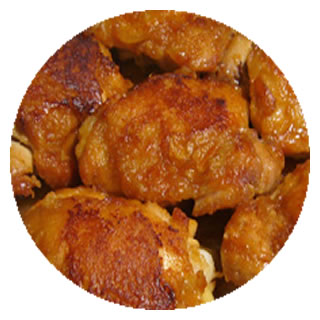 Ingredients: Ingredients:
• 2 boneless chicken breasts
• Asiago Cheese, finely grated
• flour
• salt and pepper
Directions:
1• Chop the chicken into 1 inch pieces.
2• Wash and pat dry, leaving the chicken damp.
3• In a plastic bag, mix one part flour, a half part Asiago, salt and pepper.
4• Put the chicken pieces in the bag and shake, making sure all the chicken is covered.
5• Fry the chicken in a very hot pan lined with enough oil to cover the chicken.
6• Fry until golden brown and arrange on plate.
7• Sprinkle with leftover grated Asiago and lemon juice.
Serves 2. |
 back to top back to top |
| Chicken Marsala |
| |
|
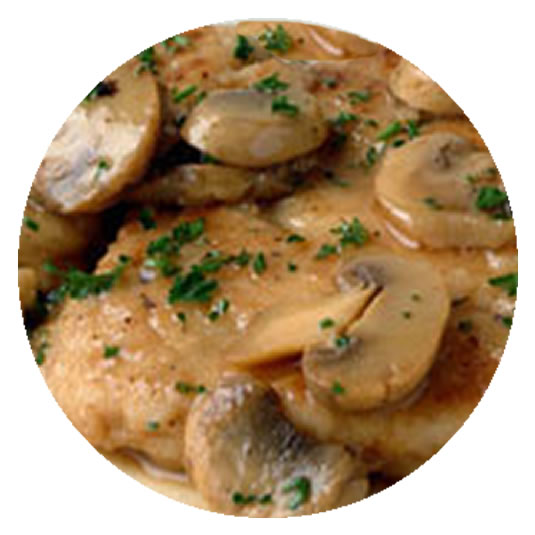 Ingredients: Ingredients:
• Two large chicken breasts sliced into thin pieces.
• 1 bottle of marsala wine (either dry or sweet according to preference).
• Whole or white flour
• Refined olive oil for cooking
• 50 grams of capers
• Juice of one large lemon
• 2 tablespoons coarsely chopped fresh parsley
• Salt and pepper.
(An equal quantity of turkey breast or lean veal may be substituted)
Directions:
1• Over medium heat, warm several tablespoons of olive oil in a large pan for a few seconds, being careful not to burn the oil.
2• Generously coat chicken pieces with flour and place in pan, turning occasionally.
3• Sprinkle with salt and pepper.
4• Add juice of one lemon.
5• When the chicken is essentially cooked, carefully pour a half bottle of marsala wine over it, stirring the mixture gently.
6• Allow alcohol to evaporate as sauce thickens. This may take about two minutes.
7• Add the parsley when it's almost done. If you prefer a thicker sauce, add a little flour.
8• Add capers last or sprinkle them over the chicken as a garnish. Serves four to six. |
 back to top back to top |
| Chicken Parmigiana |
| |
|
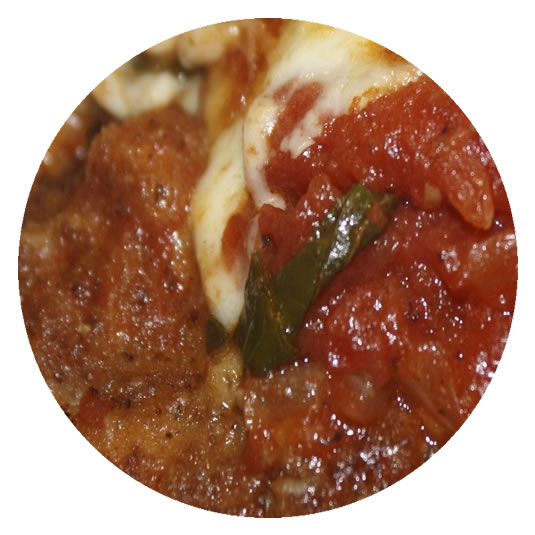 Ingredients: Ingredients:
• Boneless chicken breast (32 onz.)
• Bread crumbs
• Salt, pepper, basil
• Vegetable oil (for frying)
• Mozzarela cheese
• Parmigiano grated cheese
• Tomato sauce recipe (pasta section)
• 2 eggs
• 500 grams spaghettini
Directions:
1• Cut the chicken breast in two semi thin layers.
2• Pound them gently with a wooden kitchen sledge.
3• Place bread crumbs in a large plate.
4• Beat eggs in a soup bowl and mix in salt, pepper and basil to your liking.
5• Pass each piece of chicken breast through the egg batter.
6• Bread each side gently.
7• Heat pan with 1/4 cup vegetable oil until hot and then cook the breaded chicken until lightly browned.
8• Once all of the chicken is cooked heat the oven to 350 degrees and cover the cooked chicken with mozzarella cheese and grated parmigiano and insert in oven until the cheese is melted.
9• Meanwhile you are cooking the pasta and once the chicken is ready add a touch of tomato sauce for colour and add the pasta.
Bonne appetit. Elena |
 back to top back to top |
| Chicken in Pasta, Sun Dried Tomatoes, Asparagus |
| |
|
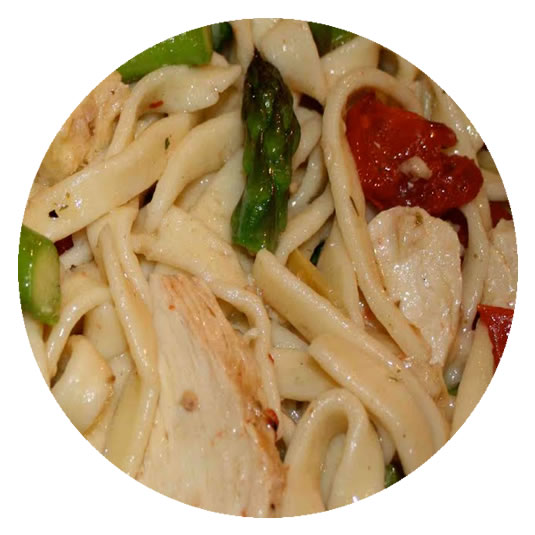 Ingredients: Ingredients:
• 1/4 cup olive oil
• 3 large boneless chicken breast halves, cut into 1-inch cubes
• 1 onion, chopped
• 1 garlic clove, chopped
• 1/2 teaspoon fennel seeds
• 500 grams fresh asparagus cleaned and cut 1 inch strips
• 1/4 cup finely chopped drained Il Fortetto oil-packed sun-dried tomatoes
• 12 ounces fettuccine, freshly cooked
• 1 cup freshly grated Parmigiano Reggiano
Directions:
1• Heat oil in heavy large skillet over medium-high heat.
2• Add chicken and saute until brown and cooked through, about 6 minutes.
3• Using slotted spoon, transfer chicken to large bowl.
4• Keep warm. Add onion, garlic and fennel seeds to skillet and saute until onion is tender, about 6 minutes.
5• Stir in asparagus and sun-dried tomatoes and continue cooking until asparagus is crisp-tender, stirring occasionally, about 2 minutes.
6• Transfer mixture to bowl with chicken.
7• Add pasta and Parmigiano Reggiano and toss well. |
 back to top back to top |
| Chicken Piccata |
| |
|
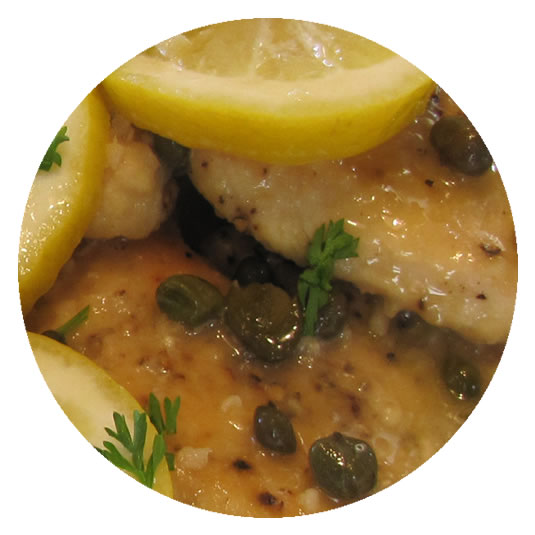 Ingredients: Ingredients:
2 whole boneless skinless chicken breasts (4 halves)
1 cup all purpose flour for dredging
1/4 cup clarified butter
1 fresh lemon
capers (to your taste)
2 small garlic cloves, mashed
3/4 cup chicken broth
Tbls. finely chopped fresh parsley
1 Tbls. whole butter
salt to taste
2 Tbls. capers (optional)
Directions:
Step One: Prepare chicken breasts
1• Remove the tenders from the breasts if they are present, the long finger-like strips. Trim all fat and sinews and remove the thin membrane covering the breasts. Butterfly the breasts starting from the plump lobe side. Press firmly with the palm of your hand to achieve uniform thickness. Do not pound with mallet.
2• Trim all fat and sinews and remove the thin membrane covering the breasts.
3• Butterfly the breasts starting from the plump lobe side.
4• Press firmly with the palm of your hand to achieve uniform thickness. Do not pound with mallet.
Step Two: Sauté chicken breasts
1• Place a 10", heavy bottomed sauté pan on high heat and add enough of the clarified butter to coat the bottom.
2• When fat is hot enough to make a drop of water sizzle, immediately dredge the chicken breasts in the flour plate, shake of excess and place in the pan. Do not dredge in advance or the flour will get pasty. Shake pan frequently to avoid sticking and continue until bottoms are golden brown.
3• Turn breasts in the pan and reduce heat to medium.
4• Cut ends from the lemon and make four thin slices (about 1/2 of the lemon), place sliced lemon in pan and squeeze the juice from the remaining half into the pan.
5• Add mashed garlic and immediately deglaze the pan by pouring at least 1/2 inch of chicken broth in it.
6• Add parsley, the tablespoon of whole butter, and capers if you are using them.
Step Three: The finish
1• Continue cooking until chicken is done. If all is perfect, the pan sauce will form right when the chicken is finished.
2• If the pan sauce has not yet come together, remove chicken from sauté pan and place on warm plates, turn heat to high and quickly reduce pan sauce to the proper consistency.
3• Spoon a generous amount of sauce over the breasts in the plate and top each breast piece with one of the cooked lemon slices
Some additional tips on this technique. Never place a sauté item in a cold pan as it will absorb fat and become greasy. When a recipe calls for pounded thin chicken breasts, use the butterfly method instead. It retains the delicate consistency of the chicken breast. Using the mallet to pound chicken breasts very thin has its place in certain instances such as a roulade, but for straight sauté, butterflying is the way to go. Always use fresh ingredients in your sauté, plastic lemon, dried garlic, and parsley flakes just do not work. For a true piccata sauce never add white wine in the sauté pan with the fresh lemon. A white wine butter sauce is a sauce unto its own.
This technique works extremely well using thin medallions of veal to create a wonderful veal piccata.
Clarified Butter
Place one pound of whole butter in a small, open topped double-boiler. Place the double boiler on the absolute lowest temperature that you can maintain for about eight hours. You can accomplish the task in the oven overnight if your oven is gas and has a high pilot heat. The butter is ready to "draw" when the salt solids floating on the top become firm and you can see the milk solids firmly on the bottom. Use a tablespoon to very gently gather and discard all of the floating solids. Without shaking the top part of the double boiler, very slowly pour off the butter into a bowl until you have drained off all that you can without the milk solids spilling over. One pound of whole butter should yield about 10 ounces of clarified butter. Clarified butter has many uses in the kitchen. Besides its outstanding performance in the sauté pan, it has no equal in dunking steamed clams, chunks of freshly boiled or steamed lobster, or a firm fish like monk fish. It also does a great job at breakfast for frying eggs or preparing a nice omelet.
If you’re going to call it piccata, capers are one of the few permissible options. I prefer mine without, but their addition is a matter of personal preference. If you decide to use capers in the dish you will want to pay particular attention when adjusting the pan sauce for salt.
Courtesy - Permission La Lama Mountain Ovens - January 7, 2011 |
 back to top back to top |
| Chicken Stuffing |
| |
|
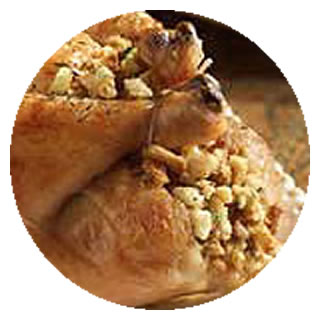 Ingredients: Ingredients:
• 1 cup finely chopped white or yellow onions
• 1 cup grated hard Italian cheese (pecorino, made from sheep's milk, is preferred)
• 1 cup bread crumbs
• One half cup chopped fresh parsley
• 2 medium-size eggs (or 1 extra large one)
• One-half teaspoon ground white pepper (black pepper may be substituted)
• 1 teaspoon virgin olive oil, salt to taste.
Interesting facts:
The residents of Caltanissetta, a small city in central Sicily, are called Nisseni, and their mountainous region is famous for meat and poultry dishes. This simple recipe offers a pleasant alternative to meat-based chicken or turkey filling. Since the size of poultry, and measurements by volume, can vary, we'll describe these by proportion. (Whether you're in the UK, the US, Brasil, Australia or Japan, this makes the precise size of a measuring cup irrelevant.)
Directions:
1• Mix the ingredients in a large bowl, kneading the mixture until it's uniform in consistency.
2• Add a little water if necessary to make it more workable. Then stuff the mixture into the cavity of the chicken or turkey before roasting.
3• In Sicily, the chicken is sometimes garnished with fresh rosemary, and Marsala wine is poured over it at several points during the baking. |
 back to top back to top |
| |
| Lamb Recipe List |
| Baked Edam with Curacao Lamb |
| |
|
 Ingredients: Ingredients:
• 2 2-pound Edam balls
• 3/4 pound freshly ground lamb
• 1 tablespoon butter, plus 2 tablespoon butter
• 1 tablespoon vegetable oil
• 1 cup finely chopped onions
• 1 firm ripe tomato, peeled, seeded and finely chopped
• 1/3 cup chopped, drained canned tomatoes 1/4 teaspoon
• 6 small pimiento-stuffed olives, drained and finely chopped
• 1 tablespoon finely chopped sweet gherkin
• 2 tablespoons seedless raisins
• 1 egg well beaten
• Ground hot red pepper 1/2 teaspoon salt (to taste) freshly ground black pepper (to taste)
• 1/4 cup soft fresh crumbs made from homemade-type white bread, trimmed of crusts and pulverized in a blender or finely shredded with a fork
Directions:
1• Peel the wax from the cheeses and cut a 1-inch-thick slice off the top of each.
2• With a spoon, scoop out the center of the cheese leaving a boatlike shell about 1/2 inch thick.
3• Hollow the slice from the top in a similar manner to make a lid for the shell.
4• Place the lid and shell in a large pan or bowl, pour in enough cold water to cover them by at least 1 inch, and let them soak for 1 hour.
5• Grate enough of the scooped-out cheese to make 2 cups and set it aside.
6• Brown the meat for a short time.
7• Remove the cheese shells and lids from the water and invert them on paper towels to drain.
8• Pre-heat oven to 350F.
9• With a pastry brush, spread the tablespoon of softened butter evenly over the bottom and sides of two round baking dishes at least 3 inches deep and just large enough to hold the cheese compactly. (If the dish is too large or shallow, the cheese will collapse and spread when it is baked.)
10• In a heavy 10-inch skillet melt the remaining 2 tablespoons of butter in the vegetable oil over moderate heat.
11• Drop in the onion and stirring frequently, cook for about 5 minutes, until the onions are soft and transparent but not brown.
12• Watch carefully for any sign of burning and adjust heat accordingly.
13• Add the tomato, pepper, salt, and a few grindings of black pepper, and still stirring, cook briskly until most of the liquid in the pan has evaporated and the mixture is thick enough to almost hold its shape in the spoon.
14• With a rubber spatula, transfer the entire contents of the skillet to a deep bowl.
15• Add the meat, grated cheese, bread crumbs, olives, gherkin, and raisins, and toss together gently but thoroughly.
16• Taste for seasoning and adjust, then stir in the beaten egg.
17• Spoon the meat mixture into each cheese shell, place the shells in the prepared dishes, and top them with the cheese lids.
18• Bake uncovered on the middle shelf of the oven for about 20 minutes or until the top is bubbly and delicatedly browned, and the meat tender.
19• Serve at once, directly from the baking dish.
Serves 6-8.
 Print this recipe - Baked Edam with Curacao Lamb Print this recipe - Baked Edam with Curacao Lamb |
 back to top back to top |
| Braised Lamb Stew on Rice |
| |
|
 Ingredients: Ingredients:
2 lbs. cubed lamb stew meat
¼ cup olive oil
2 cloves garlic, minced
2 tsp. dried rosemary or 1 Tblsp. fresh
1 tsp. salt
½ tsp. freshly ground black pepper
1 Tblsp. flour
1/3 cup red wine vinegar
1 cup chicken stock
4 anchovy filets, rinsed, dried and finely minced
Directions:
1• Preheat oven to 500 degrees and prepare the lamb stew meat. Using a 12” skillet add the olive oil and brown the stew meat well in batches that avoid crowding.
2• With slotted spoon place the browned meat in a 2 qt. casserole, with lid for later. Set the sauté pan aside.
3• Add ingredients – garlic, rosemary, salt, pepper and flour – to meat, and toss well.
4• First cook. Place the uncovered casserole in pre-heated 500 degree oven for 10 minutes until beginning to get crusty. Remove from oven and lower oven heat to 350 degrees.
5• Deglaze sauté pan. Pour any extra oil out of sauté pan and put on stove at medium high and deglaze with vinegar, scraping up any brown bits. Add 1 cup of the chicken stock and anchovies. Bring to a simmer and stir until anchovies melt. This should take about 2 to 3 minutes.
6• Finish casserole. Pour the contents of the de-glazed sauté pan into the casserole. The meat should be partially submerged but not covered with the liquid. Add more chicken stock if necessary. Cover the casserole tightly and braise in the 350 degree pre-heated oven for 1Serve this dish over plain white rice which will capture the juices nicely. If you prefer, you can serve over angel hair or linguine pasta, though rice is our choice. For you anchovy haters, please do not eliminate the anchovy secret from this recipe. You have to trust us on this one! This recipe can be doubled easily. hour 15 minutes or until fork tender.
 Print this recipe - Braised Lamb Stew on Rice Print this recipe - Braised Lamb Stew on Rice
Courtesy - Permission La Lama Mountain Ovens - January 7, 2011 |
 back to top back to top |
| Roast Leg of Lamb |
| |
|
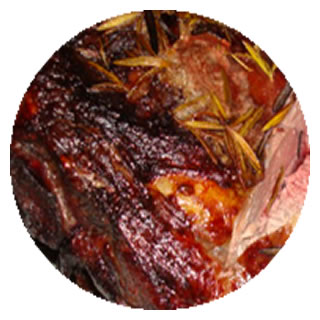 Ingredients: Ingredients:
5 to 6 lb. bone-in center cut leg of lamb
2 cloves garlic, slivered
2 Tblsp. chopped fresh rosemary
1/3 cup Dijon mustard
2 Tblsp. olive oil
2 cloves garlic, finely minced
Salt and pepper
Directions:
Step One: Prepare lamb
1• If your butcher hasn't already done so, trim almost all the fat from the top of the roast. Be sure to removed the white or silvery membrane, called the fell. With a very sharp paring knife make about 10 slits all over the roast, inserting a sliver of garlic and a little rosemary in each.
2•
Step Two: Marinate the roast
1• In a small bowl, whisk together the mustard, 2 cloves of minced garlic, olive oil, rosemary, and a few grinds of black pepper. Spread this over the roast, covering all sides.
2• Place in a non-reactive dish and allow to marinate at least four hours and up to 24 hours. If holding more than four hours, refrigerate, but allow the roast to return to room temperature before proceeding. A roast this size will take about 3 to 4 hours to come to room temperature if it is cold.
Step Three: Roasting the lamb
1• Preheat oven to 450. Place the room temperature roast in an uncovered roasting pan. Roast for 10 minutes.
2• Turn temperature down to 350 and continue roasting undisturbed to an internal temperature of 140 (for medium rare). This should take an additional 60 to 70 minutes.
3• If you like your meat less pink, wait for an internal temperature of 150. Do not overcook or the meat will be dry and tough. Let rest for five minutes. Carve and serve.
 Print this recipe - Roast Leg of Lamb Print this recipe - Roast Leg of Lamb
Courtesy - Permission La Lama Mountain Ovens - January 7, 2011 |
 back to top back to top |
| |
| Pork Recipe List |
| Pork Roast (Porchetta) |
| |
|
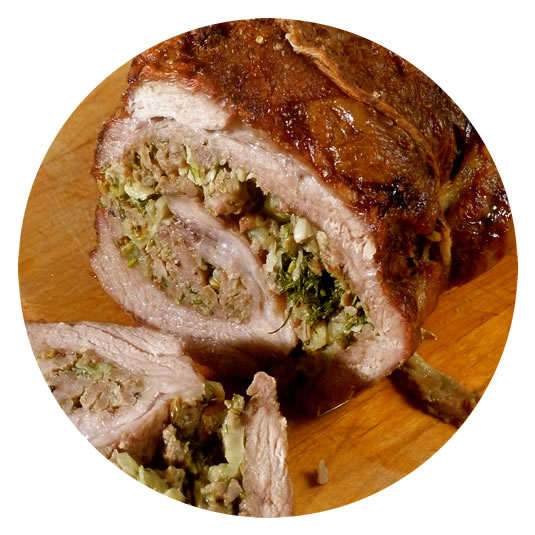 Ingredients: Ingredients:
1 Boston Butt Pork Roast
1 large clove garlic, cut longway into 8 slivers
4 large sprigs fresh rosemary, leaves only
salt and pepper
Directions:
Step One: Prepare the roast
1• Using a sharp paring knife, cut 8 evenly spaced deep crosses in the roast.
2• Place a garlic sliver in each and push to the bottom with your finger, forming a small pocket.
3• Into each pocket, pushing with your finger, put equal amounts of salt (first) and pepper (last).
4• Using a sharp paring knife, cut 8 evenly spaced deep crosses in the roast. The pocket should be loosely filled.
5• Divide the rosemary leaves into 8 equal piles and firmly plug each of the holes.
6• Give a generous sprinkle of salt and pepper over the entire roast.
Step Two: Cook the roast
1• Insert a meat thermometer into the thickest part of the roast to the center. Be careful not to have the tip of the thermometer touching a bone.
2• Place the roast in a shallow baking pan and put in a medium oven (325-350). Remove the roast when you have an internal temperature of 170-175 degrees.
3• Roasting time will vary, depending on the exact temperature of the oven, and if the roast is at room temperature or just out of the refrigerator. Let roast stand for 10 to 15 minutes to firm up a bit before serving.
This method of seasoning and cooking a pork roast will also work well with a whole fresh picnic ham (front shoulder), or a fresh ham (rear). The seasoning method also works well with a whole bone-in or boneless pork loin, however, the cooking should be changed to a very slow roast (225 degrees) and a finished internal temperature of 135-140 degrees.
Leftovers from roasts done in this style make a delicious cold pork sandwich. Thinly slice a nice stack of the cold pork roast, place on a slice of homemade bread, top with a seeded, split banana pepper, and spread a little yellow mustard on the top slice of bread.
Courtesy - Permission La Lama Mountain Ovens - January 7, 2011 |
 back to top back to top |
| Pork Stew with Eggplan |
| |
|
 Ingredients: Ingredients:
2 tbsp Extra Virgin Olive Oil 30 mL
1 lb lean,boneless pork, cubed 500 g
2 onions, sliced
1 can (28 oz/796 mL) San Marzano tomatoes
2 cups cubed peeled eggplant 500 mL
1 cup canned Pitted Olives, 250 mL sliced
salt and pepper
Directions:
1• Preheat oven to 3 0 °F (180 °C).
2• Heat olive oil in a skillet over medium-high heat. Add pork and brown on all sides.Add onions and cook for
3• minutes.Season to taste with salt and pepper.
4• Transfer mixture to a casserole or baking dish with a cover. Stir in tomatoes and eggplant.Bake in oven about 1 hour.
5• Stir in black olives. Bake another 15 minutes and serve immediately. Swiss chard makes a nice accompaniment.
4 servings |
 back to top back to top |
| Pork Marsala with Olives |
| |
|
 Ingredients: Ingredients:
1 3/4 pound cubed pork
6 ounces calamata black olives
1 can (28 oz/796 mL) San Marzano tomatoes
2 cloves garlic, minced
fresh rosemary
3/4 cup red wine
3/4 cup dry Marsala
3 tablespoons olive oil
Salt and pepper to taste
Directions:
1• Sauté the garlic and the rosemary in the olive oil, and once the garlic has turned slightly dark add the pork.
2• Brown everything, then stir in the Marsala and the wine and cook high until they have evaporated.
3• At this point stir in the tomatoes, a cup of hot water, and the calamata olives, and season to taste with salt and pepper.
4• Lower the heatm, simmer and cook for an hour and a half, by until the sauce is fairly thick.
Serves 8. |
 back to top back to top |
| Pork Sausage and Vegetables |
| |
|
 Ingredients: Ingredients:
2 lb. Italian link sausage (mild or strong or both)
1 can (28 oz/796 mL) San Marzano tomatoes
1 large green bell pepper, sliced into thick strips
1 large red bell pepper, sliced into thick strips
4 large potatoes, sliced
6 large mushrooms, sliced
1 large onion, sliced
1 tsp. garlic powder
1 tsp. fresh basil
1 tsp. dried oregano
Directions:
1• Prepare a roasting pan on the side to recieve the following cooking steps:
2• In a frying pan cook the italian sausages in olive oil until browned. Add to roasting pan
3• In a frying pan cook the green and red peppers in olive oil until browned. Add to roasting pan
4• In a frying pan cook the potatoes in conola oil until browned. Add to roasting pan
4• In a frying pan cook the onions and mushrooms in olive oil until browned. Add to roasting pan
5• Once the ingredients above are all in the roasting pan blend in all the herbs and spices let sit and when ready to serve put it in the oven for 15 minutes at 350 F.
Serves 4.
 Print this recipe - Pork Sausage and Vegetables Print this recipe - Pork Sausage and Vegetables |
 back to top back to top |
| Pork Style Italian Sausage (Hot) |
| |
|
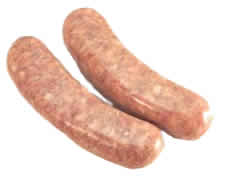 Ingredients: Ingredients:
• 20 lbs. trimmed pork butt4 lbs. cubed pork fat back
• 4 lbs. cubed pork fat back
• 8 Tblsp. salt
• 5 Tblsp. coarse ground black pepper
• 5 Tblsp. ground coriander
• 16 large garlic cloves, minced
• 8 Tblsp. crushed red pepper flakes
• 1 cup paprika
• 2 cups dry white wine
• Approximately 30 feet of casings
Preparation:
While no recipe should ever be "written in stone" I would caution you about reducing the amount of fat below what is indicated. After much experimentation this ratio of fat to meat is the smallest you can use and still have a moist and succulent sausage. Alter the seasonings to fit your taste, but remember that salt is a necessary preservative, even in a cooked final product. Fatback can be ordered from your butcher or meat distributor. This is a very dense, smooth fat used in making patés as well as sausage. By trimming the meat first you discard most all of the original fat, then add back in the correct amount of more desirable fat. This serves two purposes. First, it allows you to control the ratio of meat to fat; and second, it replaces the lower quality, loose fat on the meat which tends to gum up the blades of your grinder and stuffer. There are two schools of thought on this matter. One side does it the way I've explained and the other chooses to go with the fat that is on the pork butt and not trim it or add fresh fatback.
You can use either a table top meat grinder (with sausage stuffing attachment) or the meat grinder and sausage horn attachment to an electric mixer such as the Kitchen Aid. For both of these recipes you would use the medium or coarse plate. 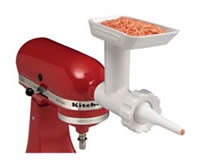 The casings are available through wholesale meat distributors or any good butcher will special order them for you. I prefer a natural hog casing which is purchased by "the hank". A hank of casings will make at least 150 pounds of sausage. Cost will run around $15 to $18 dollars, they will arrive heavily salted, and should keep in the refrigerator for at least six months. If you prefer not to use casings, the sausage can be formed into patties and be perfectly delicious if not as versatile in their use. If you do use the casings, allow a generous foot per pound. The casings are available through wholesale meat distributors or any good butcher will special order them for you. I prefer a natural hog casing which is purchased by "the hank". A hank of casings will make at least 150 pounds of sausage. Cost will run around $15 to $18 dollars, they will arrive heavily salted, and should keep in the refrigerator for at least six months. If you prefer not to use casings, the sausage can be formed into patties and be perfectly delicious if not as versatile in their use. If you do use the casings, allow a generous foot per pound.
To prepare casings: Measure off the amount of casings you will need for your recipe, being generous in your measurements in case of a tear. Soak in cold water for 15 minutes. Meanwhile clean and rinse the end of your kitchen tap (remove any aerator you may have there). Take the end of the casing and fit it onto the tap then turn the cold water on slowly. 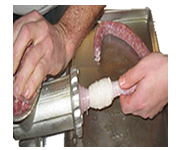 This will fill and rinse the inside of the casing and allow you to see any tears in it. Keep the bowl under the tap to catch the slippery casings and not let them go down the drain! If you find a tear, cut that piece out and discard it. Your final cleaned casing does not have to be one single piece, but should be at least 18 inches long for ease of stuffing. The longer the piece the quicker the stuffing process. Once prepared the casings should be used within an hour or they will tend to dry out and become difficult. This will fill and rinse the inside of the casing and allow you to see any tears in it. Keep the bowl under the tap to catch the slippery casings and not let them go down the drain! If you find a tear, cut that piece out and discard it. Your final cleaned casing does not have to be one single piece, but should be at least 18 inches long for ease of stuffing. The longer the piece the quicker the stuffing process. Once prepared the casings should be used within an hour or they will tend to dry out and become difficult.
A few tricks to remember: Stuffing is a two-person job. Lightly oil the sausage horn and the casings will slip right on. Turn machine on before tying the knot in the end to push out the air in the horn. As soon as you see the meat, tie your knot and stuff continuously until you either run out of meat or need to put a new casing on the horn. Tie off the end and set aside until all meat is used. Keep a straight pin within reach and as you stuff the casings, prick with the pin when you see an air bubble. This will prevent bursting and keep your sausage even and professional looking.
If you wish to link the sausage at this point, lay it out in a straight line and twist two or three times into whatever length you want. Refrigerate overnight before packaging and freezing. This allows them to dry slightly and mellows the flavor. Cook or freeze the next day.
Directions:
1• Trim and discard all visible fat and gristle from pork.
2• Cube pork and fat back into pieces to fit your grinder - not more than one inch cubes. Grind together.
2• Combine salt, pepper, coriander, garlic, red pepper and paprika in bowl and mix well. Add to ground meat mixture along with wine and mix well with your hands trying not to compact the meat.
2• Cover and refrigerate overnight. Keep meat mixture as cold as possible for ease of stuffing. Follow above directions for stuffing. Refrigerate, loosely covered, for 12 hours before cooking or freezing.
Freezer life: 4 months.
Courtesy - Permission La Lama Mountain Ovens - January 7, 2011 |
 back to top back to top |
| |
| Rabbit Recipe List |
| Rabbit Amandine (Coniglio con Salsa di Mandorle) |
| |
|
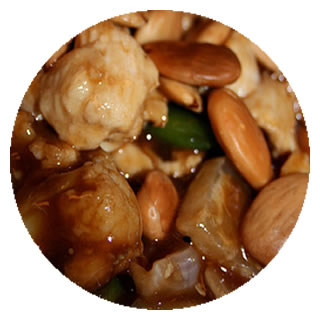 Ingredients: Ingredients:
• 1 large rabbit quartered*
• one-half bottle (about two cups) dry white wine
• a sprig of fresh laurel (bay leaves)
• a sprig of fresh rosemary
• a few small leaves of sage
• 100 grams of shelled toasted blanched ("white") almonds
• 50 grams of pine nuts
• 50 grams white or golden raisins
• 1 white or yellow onion
• 2 anchovy fillets (may be canned)
• 50 grams capers
• 2 tablespoons low-alcohol almond extract (the kind used in baking)
• extra virgin olive oil
• white pepper
• salt
*A skinless quartered chicken may be substituted if your sensibilities don't favor eating rabbit
Once favored among Sicily's aristocratic hunting set, roasted rabbit isn't as popular as it once was. Then again, neither is hunting, but today's farm-raised rabbit is no match for wild rabbit or hare, which has the unique taste of wild game. In Sicily, some rabbit or poultry is fed a traditional diet rather than commercial feed, and this "raspante" meat has a slightly gamier flavour.
Directions:
1• If it's not already quartered, cut the rabbit (or chicken) into pieces.
2• Remove the herb leaves from the stalks.
3• If you're preparing this recipe with rabbit, marinade the meat in the white wine with the rosemary, bay leaves and sage for 3-4 hours before cooking.
4• Then chop the onion into thin slices and place it in the bottom of a roasting pan with a tablespoon of olive oil. Add the rabbit and other ingredients, including the wine and herbs.
5• Roast the rabbit in the oven for an hour or more as you would roast a chicken, occasionally basting it with the wine and oil mixture.
6• The rabbit should be covered during half of the baking time, and turned over when it is about half cooked.
7• Add wine if necessary if the liquid sauce seems as if it will evaporate.
8• Meanwhile, chop the almonds and pine nuts into a fine granular consistency, almost powdery if possible.
9• Chop the anchovy fillets into a paste.
10• In a mixing bowl, thoroughly combine the almond-pine nut mixture with the anchovy paste, almond extract, the juice of one lemon, the capers and raisins.
11• When the rabbit is completely cooked, remove it from the oven and quickly stir in this combined paste before serving, adding a little olive oil and water if it seems too liquid. You may wish to remove the bay leaves.
12• Salt and pepper lightly to taste.
13• Italian arborio rice, prepared as risotto, makes a nice complement to Rabbit Amandine. |
 back to top back to top |
| Rabbit with Cognac and Black Calamata Olives |
| |
|
 Ingredients: Ingredients:
• 2 pounds fresh rabbit, cut into pieces (butcher cuts)
• 4 tablespoons of olive oil
• 4 tablesppons of vegetable oil
• 1 onion, chopped
• 1 garlic clove, chopped
• 3 ounces cognac
• 4 tablespoons beef bouillon concentrated with 2 cups water or stock
• 40 calamata olives
• salt, pepper and basil
• small container mushrooms
• 1 tablespoon of baking soda with two ounces water
• 5 medium potatoes (side order)
Directions:
1• Lightly brown pieces of Rabbit in the olive oil and vegetable oil.
2• Add the onion and garlic and garnish with salt and pepper cook for 10 more minutes.
3• Sautee with cognac until flame half down
4• Season with salt, pepper and basil as needed to taste
5• Prepare an oven pot with cover and add the beef bouilon or stock
6• Add the cooked rabbit ingredient and let cook for 35 minutes in oven at 350 degrees.
7• Remove cover and let cook for 25 minutes.
8• Add mushrooms and olives and let cook for 15 more minutes
9• Remove oven pot from oven and add one tablespoon baking soda to two ounces of water, wisk and add to thicken.
10• Put back in oven for five more minutes for thickening and serve
11• Meanwhile fry the potatoes for side dish with a nice green italian salad and a bottle of wine. courtesy Elena
Serves 6-8.
 Print this recipe - Rabbit with Cognac and Black Calamata Olives Print this recipe - Rabbit with Cognac and Black Calamata Olives |
 back to top back to top |
| Rabbit Sweet and Sour |
| |
|
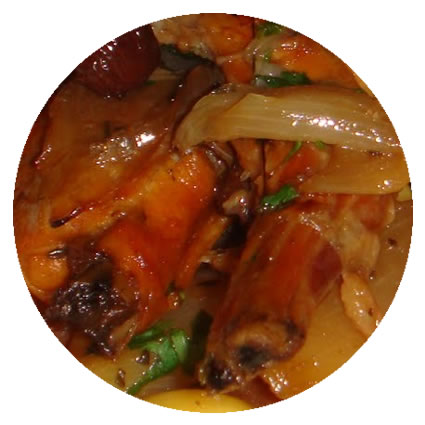 Ingredients: Ingredients:
• 2 fresh rabbits (specialty ethnic butcher shop)
• White all purpose flour
• 40 pitted green olives, chopped
• 2 tsps capers
• 1 onion, sliced
• 2 curry leaves
• 1 cup white wine vinegar
• 2 tablespoons sugar
• Olive oil
• Salt and Pepper
Directions:
1• Cut the rabbits into 12 pieces (both rabbits)
2• Add the cut pieces in flour to coat them all around. Coat them all one at the time and set them aside.
3• In a frying pan brown the rabbit pieces well in the hot oil until gently seared.
3• Heat a little more oil in a second pan and cook the onion golden, then add the capers, olives, and curry leaves.
4• Transfer the browned rabbit pieces to the second pan, season them with salt and pepper, dust them generously with sugar, and sprinkle the vinegar over them.
5• Reduce the heat to a simmer and cook the rabbit until it's tender, the vinegar will evaporate, so as to produce a thick sauce.
Serves 4 - 6
 Print this recipe - Rabbit Sweet and Sour Print this recipe - Rabbit Sweet and Sour |
 back to top back to top |
| |
| Turkey Recipe List |
| Italian Turkey Stuffing |
| |
|
 Ingredients: Ingredients:
1 large onion, roughly chopped
3 stalks celery, roughly chopped
1 pound lean ground beef
1 pound lean ground pork
1 hot Italian sausage, casing removed and broken into pieces (optional)
14 ounces seasoned bread stuffing mix
2 cups chicken broth, defatted
2 eggs, lightly beaten
1 teaspoon poultry seasoning
1/2 teaspoon rubbed sage
Salt and pepper to taste
1/2 cup butter, melted
Directions:
1• Heat olive oil in medium sauté pan. Stir in onion and celery and cook over medium heat until transparent.. Transfer to a large bowl and set aside.
2• Sauté beef, pork and optional sausage, breaking up until no longer pink. Remove with slotted spoon to a separate bowl and set aside. Let cool slightly.
3• Using a large soup pot to combine ingredients, pour in stuffing mix, cooled meat and onion mixture. Add chicken broth and mix well
4• Stir in eggs, poultry seasoning and sage. Season with salt and pepper to taste. Pour over butter and mix well. If not moist enough, add more broth.
5• Stuff into turkey and put remainder into a casserole. Casserole must be at least 160°F when done.
Serves: 8 - 10 with turkey |
 back to top back to top |
| Roast Turkey |
| |
|
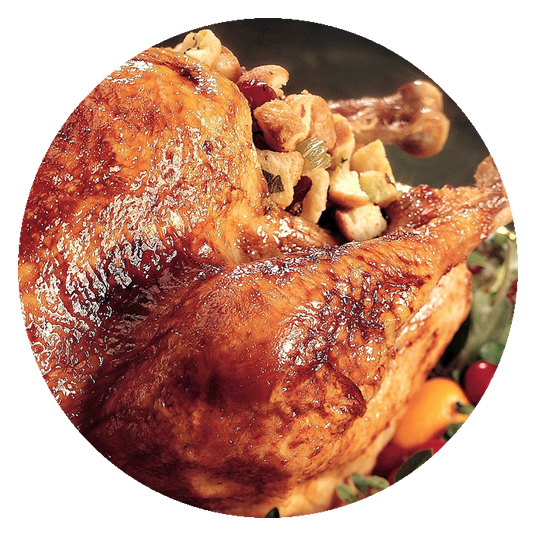 Ingredients: Ingredients:
4 cloves garlic, crushed
1/4 cup (50 mL) chopped fresh rosemary
1/4 cup (50 mL) extra virgin olive oil
1 tbsp. (15 mL) table salt
1 tsp. (5 mL) black pepper
12 to 15 lb. fresh whole turkey
Directions:
1• Preheat oven to 325 degrees F (160 degrees C).
2• In a small bowl or food processor, mash together garlic, rosemary, olive oil, salt and pepper so that it forms a thick paste.
3• By hand, gently pull the skin away from the turkey breast at the front of the breast (near the neck opening) to form a sort of pocket. Rub some of the rosemary garlic paste onto the breast meat under the skin, reaching in as far as you can without tearing the skin. Rub the remaining rosemary garlic paste all over the skin of the turkey and in the cavity. Add the stuffing, if you're using it, and place the turkey, breast side up, on a rack in a shallow roasting pan. Tuck the wings underneath the bird and tie the legs together with kitchen string.
4• Place the turkey into the preheated oven. Do not cover the pan. Roast, basting every 15 to 20 minutes with the pan juices, until a meat thermometer inserted into the inner thigh reaches 170 degrees F (77 degrees C) and the juices run clear when the thigh is pricked with a skewer. This will take anywhere from 3 to 4-1/4 hours (depending on the size of the turkey and whether it is stuffed or not). The only definite way to know if the turkey is cooked is by using a meat thermometer. Remove roasting pan from the oven and let the turkey rest at room temperature for about 15 minutes before carving.
5• Serve turkey with pan juices or use the juices to make gravy (recipe follows).
Gravy for Turkey
1• 1/4 cup (50 mL) fat from the roasting pan
2• 1/4 cup (50 mL) flour
3• 2 cups (500 mL) defatted turkey pan juices, turkey broth, water, or a combination
4• In a saucepan, combine the fat from the roasting pan and flour. Cook, stirring to eliminate any lumps, for just a minute or two. Whisk in turkey juices, broth or whatever liquid you're using and cook, stirring constantly, until the gravy thickens. Let simmer over low heat, whisking occasionally, for 6 to 8 minutes. Serve hot. |
 back to top back to top |
| Turkey Filets with Parmigiano Reggiano |
| |
|
 Ingredients: Ingredients:
• 1 lb. breast of turkey, cut into slices
• 1 egg, lightly beaten
• 1 cup breadcrumbs
• 1 tablespoon butter
• 5 oz. Parmigiano Reggiano, cut into slivers
• vegetable oil
Directions:
1• Dip each turkey slice on both sides in the egg and then into the breadcrumbs.
2• Heat the oil in a skillet over medium heat and cook the turkey slices.
3• When done, transfer to a butter smeared baking dish, cover with Parmigiano Reggiaino and place in an oven preheated to 400 degrees for 10 minutes.
4• Serve immediately.
Serves 4 to 6 people. |
 back to top back to top |
| |
| Veal Recipe List |
| Lemon Veal Piccata - Scaloppine Al Limone |
| |
|
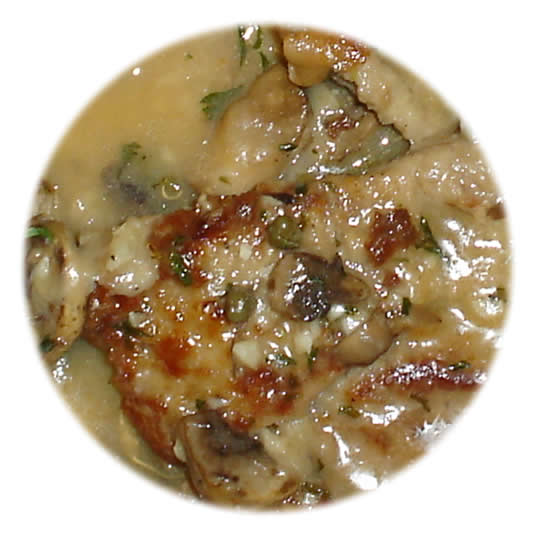 Ingredients: Ingredients:
4 large veal cutlets (milk fed veal for tenderness)
all purpose flour
salt and pepper
2 tablespoons olive oil
2 tablespoons butter
1/2 cup dry white wine
1 cup chicken stock
4 tablespoons lemon juice
2 tablespoons capers rinsed and chopped
2 tablespoons finely chopped parsley
Directions:
1• Pound veal (already portioned by butcher) with a meat mallet until an even thickness has been achieved.
2• Lightly dust with flour on both sides.
3• Add olive oil and butter in a frying pan over moderately high heat for at least 2 minutes on each side. Season and transfer to plate.
4• Add the wine to the pan and increase the heat to high and boil until there are just 3 tablespoons of liquid left.
5• Pour in the stock and boil for 5 minutes or until it has reduced and slightly thickened. Add the lemon juice and capers and cook, stirring for one minute.
6• Taste for seasoning and return the veal cutlets to the pan and heat through for 35 seconds. Sprinkle with parsley and serve at once.
Preparation Time: 10 minutes
Cooking Time: 10 minutes
Makes 4 servings |
 back to top back to top |
| Marsala Veal - Scaloppine A la Marsala |
| |
|
 Ingredients: Ingredients:
• 18 pieces of milk fed veal. Pounded gently with kitchen wooden hammer.
• 1 cup of marsala wine (either dry or sweet according to preference).
• Whole or white flour
• Refined olive oil for cooking
• 50 grams of capers
• Juice of one large lemon
• 2 tablespoons coarsely chopped fresh parsley
• Salt and pepper.
Directions:
1• Over medium heat, warm several tablespoons of olive oil in a large pan for a few seconds, being careful not to burn the oil.
2• Generously coat veal pieces with flour and place in pan, turning occasionally.
3• Sprinkle with salt and pepper.
4• Add juice of one lemon.
5• When the veal is essentially cooked, carefully pour marsala wine over it, stirring the mixture gently.
6• Allow alcohol to evaporate as sauce thickens. This may take about two minutes.
7• Add the parsley when it's almost done. If you prefer a thicker sauce, add a little flour.
8• Add capers last or sprinkle them over the chicken as a garnish. Serves four to six. |
 back to top back to top |
| Milanese Veal (breaded) - Scaloppine A la Milanese |
| |
|
 Ingredients: Ingredients:
8 large veal cutlets (milk fed veal for tenderness)
salt and pepper
2 eggs
1 cup dried bread crumbs
4 tablespoons grated romano cheese
3 tablespoons butter
2 tablespoons olive oil
1 whole lemon cut in wedges
Directions:
1• Pound veal (already portioned by butcher) with a meat mallet until an even thickness has been achieved.
2• Beat eggs add salt, pepper and pour in a dish.
3• Dip each chop in the batter, coating it on both sides. Shake off the excess batter.
4• Coat the veal in the bread crumb mix. Pressing each side firmly into the crumbs.
5• Heat the butter and oil in a large frying pan and heat. Add the the veal and fry gently for 3 minutes on each side or until the bread crumbs are deep golden.
Serve immediately with the lemon wedges.
Preparation Time: 10 minutes
Cooking Time: 10 minutes
Makes 4 servings |
 back to top back to top |
| Osso Bucco Veal - Braised Veal Shanks |
| |
|
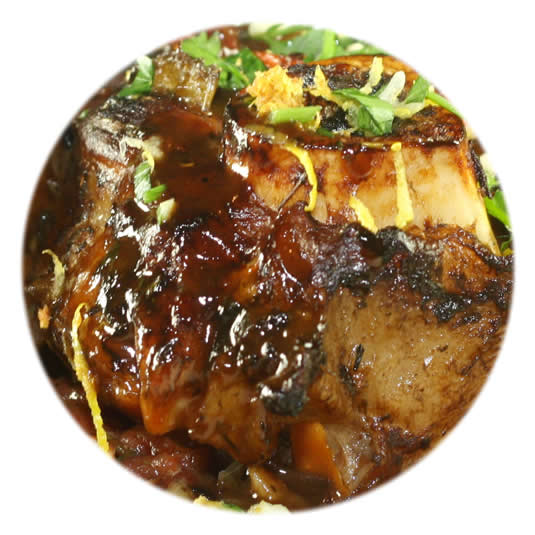 Ingredients: Ingredients:
2 tbsp vegetable oil 25 mL
2 lbs centre-cut veal shanks 900 g
1 tbsp butter 15 mL
2 carrots, finely chopped 2
2 celery stalks, finely chopped 2
1 onion, finely chopped 1
1 can (28 oz/796 mL) PRIMO Tomatoes, drained 1
1 1/2 cups chicken stock 375 mL
1 bay leaf 1
1/2 tsp each salt, pepper, dried basil and thyme 2 mL
1/3 cup finely chopped fresh parsley 75 mL
2 garlic cloves, minced 2
4 cups Gnocchi 1 L
zest of 1 lemon, minced
Directions:
1• In large, heavy saucepan, heat oil over medium-high heat. Brown shanks in batches, approximately 1 minute per side. Remove from pan and set aside.
2• Add butter to pan and reduce heat to medium. Add carrots, celery and onion; cook 15 minutes, or until softened and lightly browned, stirring occasionally.
3• Stir in tomatoes, chicken stock, bay leaf, salt, pepper, basil, thyme and browned veal shanks; bring to a boil. Reduce heat to low, cover and cook 2 hours, or until meat is very tender.
4• Combine parsley, garlic and lemon zest; set aside.
5• Meanwhile, in a large pot of boiling, salted water, cook gnocchi 8-10 minutes, or until tender but firm; drain.
6• Serve osso buco over gnocchi sprinkled with the parsley mixture.
Preparation Time: 10 minutes
Cooking Time: 2 hours, 20 minutes
Makes 4 servings |
 back to top back to top |
| Pizzaiola Veal (tomato) - Scaloppine A la Pizzaiola |
| |
|
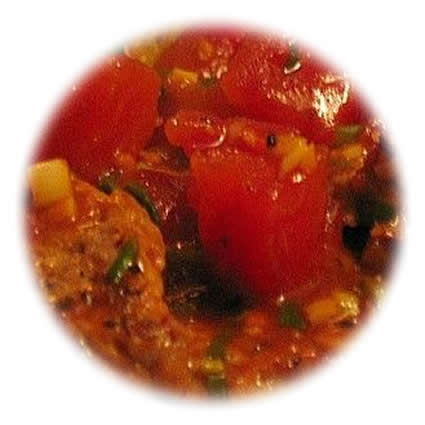 Ingredients: Ingredients:
4 large veal cutlets (milk fed veal for tenderness)
salt and pepper
4 tablespoons olive oil
1 1/2 cup crushed tomatoes
1 garlic cloves crushed
4 basil leaves diced
2 tablespoons finely chopped parsley
Directions:
1• Heat frying pan with olive oil and add garlic. Cook until lightly browned
2• Add the tomatoes to pan and season
3• In another frying pan add olive oil lightly and fry veal for 2 minutes or when lightly browned.
4• Add cooked veal to seasoned tomato sauce and cook over low heat for 5 minutes.
5• Sprinkle the parsley over the top and serve at once.
Preparation Time: 10 minutes
Cooking Time: 10 minutes
Makes 4 servings |
 back to top back to top |
| Parmigiana Veal (au gratin) - Scaloppine A la Parmigiana |
| |
|
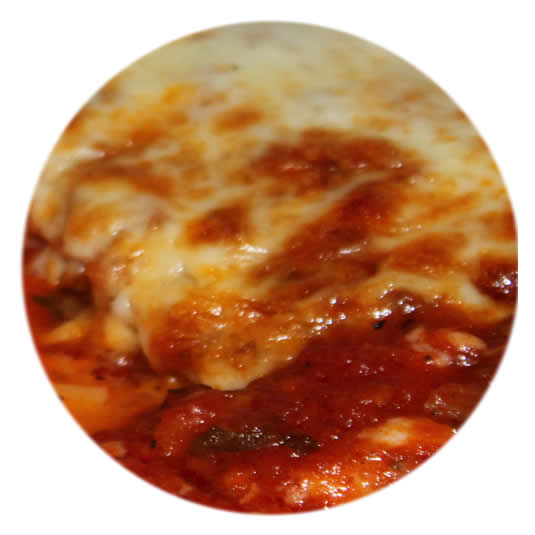 Ingredients: Ingredients:
Milk Fed Veal - 12 pieces
Bread crumbs
Salt, pepper, basil
Vegetable oil (for frying)
Mozzarela cheese
Parmigiano grated cheese
Tomato sauce recipe (pasta section)
2 eggs
500 grams spaghettini
Directions:
1• Pound the veal gently with a wooden kitchen sledge.
3• Place bread crumbs in a large plate.
4• Beat eggs in a soup bowl and mix in salt, pepper and basil to your liking.
5• Pass each piece of veal through the egg batter.
6• Bread each side gently.
7• Heat pan with 1/4 cup vegetable oil until hot and then cook the breaded veal until lightly browned.
8• Once all of the veal is cooked heat the oven to 350 degrees and cover the cooked veal with mozzarella cheese and grated parmigiano and insert in oven until the cheese is melted.
9• Meanwhile you are cooking the pasta and once the veal is ready add a touch of tomato sauce for colour and add the pasta.
Bonne appetit. Elena |
 back to top back to top |
| Rotolo of Veal - Scaloppine Rotolo |
| |
|
 Ingredients: Ingredients:
1 1/4 lb. boned breast of veal
1/4 cup Olio Carli Extra Virgin olive oil
6 to 7 sage leaves
Salt and pepper
1/4 ham, not smoked
1/3 cup shelled peas
1/4 freshly grated Parmigiano Reggiano
1 whole egg
The juice of one lemon
Directions:
1• Rub the veal with one tablespoon olive oil. Sprinkle with salt and pepper.
2• Combine the sage leaves, chopped ham, peas, Parmigiano Reggiano and the egg and spread the mixture over the veal.
3• Roll up the meat tightly and fasten with string. Place the meat in a baking dish, pour over it the lemon juice and remaining olive oil and cook in preheated oven at 375 degrees for one hour or until tender at the pricking of a fork.
Serves 4 people. |
 back to top back to top |
| Saltimbocca Veal - Scaloppine Saltimbocca |
| |
|
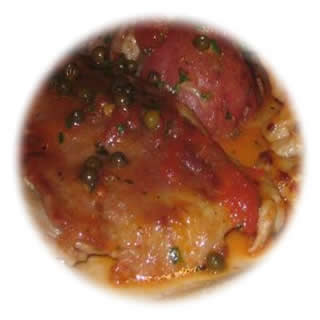 Ingredients: Ingredients:
4 slices of prosciutto
4 veal scalloppine thinly sliced and pounded
flour spread on a plate for dredging
2 tablespoons olive oil
2 tablespoons butter
4 sage leaves
1/2 cup dry white wine
1/4 cup chicken broth
salt and pepper to taste
Directions:
1• Place one slice of prosciutto on each veal scalloppine and pound in lightly with a meat pounder.
2• Heat olive oil in a large sauté pan over medium-high heat. Dredge both sides of the scalloppine in flour to coat, shaking off any excess. Place them prosciutto side down in pan and cook, turning once, until lightly browned on both sides. Transfer to a warm plate.
3• Drain oil from pan, place back over heat and add butter. When butter is melted add sage and sauté for one minute.
4• Add the white wine and scrape loose any bits from bottom of pan, then add the chicken broth and salt and pepper.
5• Place scalloppine back in pan, prosciutto side up and cook until sauce is reduced by half and scalloppine are heated through.
6• Transfer veal to serving plates, spoon sauce over top and serve. |
 back to top back to top |
| |
| Waterfowl Recipe List |
| Italian Roast Duck |
| |
|
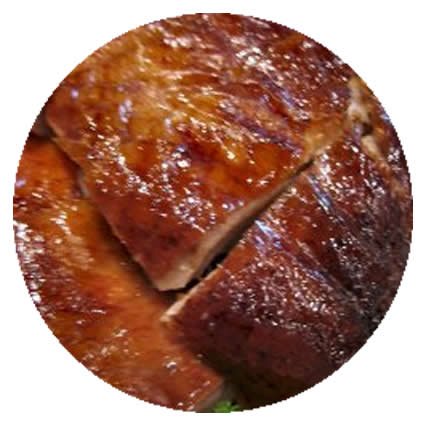 Ingredients: Ingredients:
• 1 fresh duckling, or duck, about 4 pounds
• fresh ground black pepper
• salt
• juice from 4 or 5 fresh oranges
• 1/3 cup Cognac
• 1 sprig fresh rosemary
• 1/4 cup melted butter
• 1 small carrot
Directions:
1• To cook duck rub salt and pepper on the duck, inside and out.
2• Cut rosemary in half and place in the cavity.
3• Combine the orange juices, melted butter and Cognac in a small bowl. This will be used for basting.
4• Place carrot and duck in a roasting pan lined with aluminum foil and roast uncovered for about 2 hours at 350 degrees.
5• Baste duck frequently (at least every 20 minutes).
6• When done, allow to cool a few minutes then cut into serving pieces. Serve with rice, Italian pasta or polenta. For added flavor, spoon roasting juices over servings.
Cooking secret:
When cooking duck and other waterfowl, roast uncovered, baste often and allways be sure to add a carrot. This will help to absorb the grease and strong taste. |
 back to top back to top |




 Ingredients:
Ingredients:


 Ingredients:
Ingredients: Ingredients:
Ingredients:

 Ingredients:
Ingredients: Ingredients:
Ingredients:
 Ingredients:
Ingredients:

 Ingredients:
Ingredients:



 Ingredients:
Ingredients:

 The casings are available through wholesale meat distributors or any good butcher will special order them for you. I prefer a natural hog casing which is purchased by "the hank". A hank of casings will make at least 150 pounds of sausage. Cost will run around $15 to $18 dollars, they will arrive heavily salted, and should keep in the refrigerator for at least six months. If you prefer not to use casings, the sausage can be formed into patties and be perfectly delicious if not as versatile in their use. If you do use the casings, allow a generous foot per pound.
The casings are available through wholesale meat distributors or any good butcher will special order them for you. I prefer a natural hog casing which is purchased by "the hank". A hank of casings will make at least 150 pounds of sausage. Cost will run around $15 to $18 dollars, they will arrive heavily salted, and should keep in the refrigerator for at least six months. If you prefer not to use casings, the sausage can be formed into patties and be perfectly delicious if not as versatile in their use. If you do use the casings, allow a generous foot per pound. This will fill and rinse the inside of the casing and allow you to see any tears in it. Keep the bowl under the tap to catch the slippery casings and not let them go down the drain! If you find a tear, cut that piece out and discard it. Your final cleaned casing does not have to be one single piece, but should be at least 18 inches long for ease of stuffing. The longer the piece the quicker the stuffing process. Once prepared the casings should be used within an hour or they will tend to dry out and become difficult.
This will fill and rinse the inside of the casing and allow you to see any tears in it. Keep the bowl under the tap to catch the slippery casings and not let them go down the drain! If you find a tear, cut that piece out and discard it. Your final cleaned casing does not have to be one single piece, but should be at least 18 inches long for ease of stuffing. The longer the piece the quicker the stuffing process. Once prepared the casings should be used within an hour or they will tend to dry out and become difficult. Ingredients:
Ingredients: Ingredients:
Ingredients:

 Ingredients:
Ingredients: Ingredients:
Ingredients: Ingredients:
Ingredients:




 Ingredients:
Ingredients: